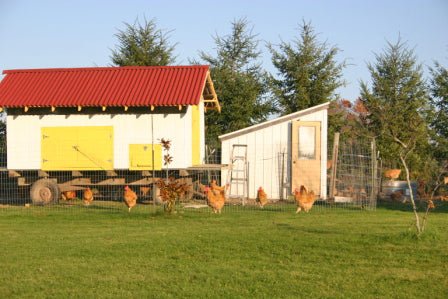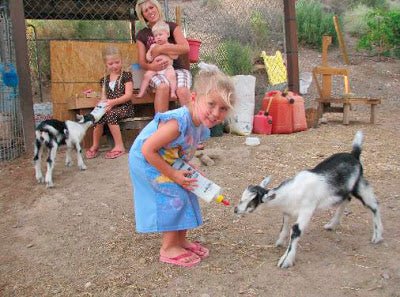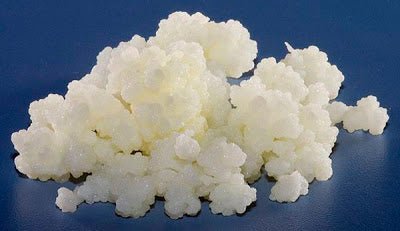 |
| Caroline in her new cheese kitchen |
Life after the Year of Yeast Contamination…
Back in May, we did an article about Caroline Abbott in Otsego, Michigan who had “mystery holes” in her goat cheese. After months of research and experimentation, she finally realized that it was being caused by yeast bacteria in the air from making bread.
Recently, Caroline told us she had solved the problem by setting up a new cheese kitchen in her basement. Now she’s back in “business” making all kinds of cheeses for her family…
 |
| Abbott Farm |
So, what’s new?
After all these months, I finally have my new cheese kitchen! All summer long my daughter has been making bread outside on the deck. Now it is starting to get cold, and she really can’t do that anymore, so it was just in time!
We made A LOT of cheese this summer. At one time my daughter was making two two-pound cheeses a day six days a week. We filled up one beverage cooler and a dorm refrigerator and bought another beverage cooler and filled that up!
The goats are still producing well enough to make cheese at least four days a week, which is really good for this time of year.
We have been able to start EATING our way through the oldest cheeses, which makes room in the coolers for more new cheese.
 |
| Caroline’s daughter, Anneliese |
We went on vacation for two weeks in September and my farm sitter made cheese for two weeks and had no problems! We are eating colby, co-jack, gouda, manchego and some montasio.
We opened up a romano from May 31 and it didn’t have much flavor yet. I think I waxed the romanos too early, so they are not dry enough. We have made a couple since we got home and I will leave them a little longer before waxing.
What is your “make room” like?
We have a large basement with a walk-out. Half of it is finished, the back half is divided into three unfinished rooms, the center room is the furnace room and we have three deep freezers and a large refrigerator for our milk in there.
 |
| New beverage cooler |
The other two rooms were just unfinished storage rooms. I homeschool my kids, and one of the finished rooms is our school room. Off of the school room is one of the unfinished storage rooms, which I was using for storing my home-made soap and my bottles and baskets. That is the room we converted into a kitchen.
It is 9′ X 12′, so it is large enough for the kitchen counter, sink and stove, plus room for shelving for storage for some of my soap and lotion supplies, as well as canning equipment and other “food” equipment that has been tucked into places all over the basement and kitchen upstairs.
We built our house eight years ago. Originally the room we made into the cheese kitchen we planned to make into a dark room someday, so we had the plumber set the pipes to put in a sink someday. That made things a lot easier, because the floor is poured concrete, which would have made a big headache for putting in a sink.
Since it is right off the school room, my younger kids can use it for science experiments, too. My older kids are jealous of that – they had to do everything upstairs and improvise. We just are making sure they don’t do any experiments involving yeast in there!
 |
| Older beverage cooler |
How are you aging your cheese?
The coolers are actually beverage coolers by Haier. They are just like wine coolers except they have flat shelves instead of shelves designed to hold wine bottles. They look just like the little coolers you see at the checkout at stores with the pop and water in them.
Because they are designed for beverages, they stay around 50 degrees, perfect for cheese. I got mine at Sam’s Club, the most recent one was $120 and we probably have 50 cheeses packed in there. Our area of the country doesn’t have any natural caves, so this is terrific.
What have you learned lately?
Before we had our yeast contamination issue we had spent three years experimenting and perfecting our cheese making. We settled on the recipes that worked for us, that we liked and that were practical for our setting.
We “tweaked” recipes based on what worked in our setting, for instance, we discovered that it was inconsistent to attempt brining Italian cheeses because unless you make a new brine each time (using 2 pounds of salt!), you don’t know the exact salinity of your brine.
We had problems with our cheeses molding. So, after some experimentation, we discovered we could salt the curds like we did with our mesophilic cheeses and it tasted the same and gave us a consistent result. Much easier, without a big jar of brine taking up space in the refrigerator.
 |
| Taking cheese out of the press |
Another thing we learned along the way was that smaller parmesans and romanos need to be waxed at some point, or they turn into a rock! But, like I said before, we are still working out the exact timing on that, so they aren’t too moist.
We also learned that we like colby to be moist. The temperature at which you wash the curd and bring it down to determines how moist the cheese ends up.
 |
| Making Mozzarella |
All this explanation is to tell you that we developed recipes and procedures that work and taste like we like. We make these over and over and can make them without even looking at a recipe now because we know the procedure so well.
So, although we don’t take notes, we know what we do and have worked it out to something we do without even thinking about it. Some things we have written out in step by step format for teaching purposes, especially if it varies significantly from a recipe in a book. We aren’t done “tweaking”.
We are always figuring out ways to make it more practical. Like just recently we discovered it works just as well to “cook” the curd on the stove as it does to do it in the sink in hot water. It takes less time, less energy, less water and the result is the same.
Because I make so many pressed cheeses, I have found it is easier to use the disposable cheese cloth available from New England Cheesemaking. I bought a bulk pack (twelve at a time, I think), and it lasts a long, long time.
As I have the opportunity to teach more people how to make cheese, new questions come up that make us look at how we do things to determine if it can be done a better way. When we discover something that works, we keep doing it until it becomes part of the routine.
 |
| Abbott chickens |
 |
| Abbott turkeys |



















































































































































